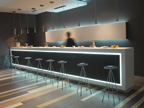

While these are among the handful of trends that can be gleaned from our retailer survey on the ceramic/stone segment, the study also suggests that the category cannot be neatly pigeon-holed. It is clear that retailers have a wide range of views on how much space to devote to ceramic and stone products and what brands to carry. What's more, the portion of respondents who said the average ceramic/stone transaction was less that $3,000 was almost exactly matched by those who said it exceeded that figure. The key area of consensus, however, is that it is an important area of the flooring business, particularly in the residential segment which, respondents said, accounts for nearly 80% of their sales in the category. Most said they expect to see continued growth for the remainder of the year. After that, finding an "industry norm" for ceramic/stone sales is elusive.

Perhaps most notably there are various views on how much space should be devoted to the category. Just over one-third of the respondents said their ceramic/stone section occupies from 11-20% of their total floor space, while 30% said the figure is between 21% -50% and another 29% said it is under than 10% (Only 7% said they devote more than half their display area to it.) Similarly, when asked "Of your total tile sales, what percentage is of porcelain tile?" one-fifth of the respondents said it was from 11 to 25% while 24% said it was from 26 to 30% and 17% said the figure was from 31 to 50%. Nearly one-third indicated it was more than 50% of their business.
A question about the average ticket amount of a transaction in the category brought a similar disparity: 32% of the survey participants say it was less than $1,000, 20% said it was $1,000 to $2,900, 30% said $3,000 to $4,999 and 18% reported that the average ticket is greater than $5,000. (The amount of product sold with each transaction is similarly fragmented.)

When respondents were asked separately to name their top selling ceramic and stone brands the answers were, once again, all over the map. While Dal Tile commands a dominant position in ceramic with 23% of the respondents identifying it as their best seller, those participating in the survey collectively identified more than 43 brands as their No.1 seller. Apart from Dal Tile, only two other brands-Mohawk and American Olean-were mentioned by more than 10% of the respondents. Rounding out the top seven best selling brands are Shaw (7%), Florida Tile and Interceramic (5% each), and Mannington (3%).

While the reasons cited for the popularity of each brand also varied, one constant was a wide selection. In the case of Dal Tile, selection was the most frequently mentioned reason followed by price, style and availability. For Mohawk it was price, selection, availability and styling. American Olean got high marks for its display, price, selection and availability. Shaw's key strengths were availability, price and style, according to the survey.

For the stone portion, respondents collectively named 31 brands as their No. 1 seller. Dal Tile also topped this list. It was named by 22% of respondents and was singled out for its selection, availability and style. Other top-selling stone brands (followed by the percent of respondents who named it and the key reasons for the choice) were: Travertine (12% good looks, price and color); Emser (9% price, return policy, good reputation) and American Olean (6% availability, selection and specification).

As is often the case in other flooring categories, the issue identified as having the most affect on specialty store business is the growing number of big box channels, which was cited by 66% of the respondents. Other issues (and the percentage of respondents who listed them) were: Increasing competition from other flooring channels (53%); eroding profit margins (46%), other floor types (32%); consolidating retailers & manufacturers (26%); and consumer brand switching (11%).

A follow-up question asked respondents what effect big box stores currently have on their business and what effect they are likely to have in the next 18 months. Respondents were asked to rank the effect on a scale from one to five. While 48% of the respondents said the current effect was neutral, that figure dropped to 37% when the question looked in the 18 months. Interestingly, 15% said the effect right now was positive or very positive and that figure grew to 22% for the 18 month outlook. At the same time 37% said the effect was negative or very negative and that figure grew to 41% for the longer term outlook.

Editor's Note: National Floor Trends commissioned another in our ongoing series of market studies to help flooring retailers/contractors enhance the success and profitability of their businesses. Identifying current product/sales trends and projecting the industry's future direction is imperative to making strategic decisions that ensure growth and prosperity.
Our 2005 Ceramic/Stone Tile Market Study is based upon responses from a sample of 1,500 active, qualified flooring dealers/contractors selected on an Nth name basis from the domestic circulation list of NFT subscribers. A 12% response rate by specialty retailers provides the data for this study. The study was designed and conducted by the market research division of BNP Media in conjunction with the editorial staff of National Floor Trends.
The complete 2005 Ceramic/Stone Market Study is available for $225 each and $195 for multiple copies.


